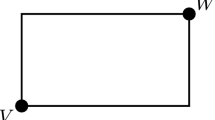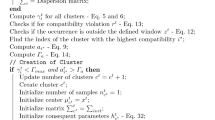Abstract
An approach to apply ensembles of regression models, built over the chunks of a data stream, to aid in residential premises valuation was proposed. The approach consists in incremental expanding an ensemble by systematically generated models in the course of time. The output of aged component models produced for current data is updated according to a trend function reflecting the changes of premises prices since the moment of individual model generation. The method employing general linear model, multiple layer perceptron, and radial basis function networks was empirically compared with evolving fuzzy systems designed for incremental learning from data streams.The results showed thatevolving fuzzy systems and general linear models outperformed the ensembles built using artificial neural networks.
Access this chapter
Tax calculation will be finalised at checkout
Purchases are for personal use only
Preview
Unable to display preview. Download preview PDF.
Similar content being viewed by others
References
Nguyen, N., Cripps, A.: Predicting housing value: A comparison of multiple regression analysis and artificial neural networks. J. of Real Estate Research 22(3), 313 (2001)
Selim, H.: Determinants of house prices in Turkey: Hedonic regression versus artificial neural network. Expert Systems with Applications 36, 2843–2852 (2009)
D’Amato, M.: Comparing Rough Set Theory with Multiple Regression Analysis as Automated Valuation Methodologies. Int. Real Estate Review 10(2), 42–65 (2007)
Kontrimas, V., Verikas, A.: The mass appraisal of the real estate by computational intelligence. Applied Soft Computing 11(1), 443–448 (2011)
García, N., Gámez, M., Alfaro, E.: ANN+GIS: An automated system for property valuation. Neurocomputing 71(4-6), 733–742 (2008)
González, M.A.S., Formoso, C.T.: Mass appraisal with genetic fuzzy rule-based systems. Property Management 24(1), 20–30 (2006)
Guan, J., Zurada, J., Levitan, A.S.: An Adaptive Neuro-Fuzzy Inference System Based Approach to Real Estate Property Assessment. J. of Real Estate Res. 30(4), 395–421 (2008)
Lughofer, E., Trawiński, B., Trawiński, K., Kempa, O., Lasota, T.: On Employing Fuzzy Modeling Algorithms for the Valuation of Residential Premises. Information Sciences 181, 5123–5142 (2011)
Lasota, T., Telec, Z., Trawiński, B., Trawiński, K.: Investigation of the eTS Evolving Fuzzy Systems Applied to Real Estate Appraisal. Journal of Multiple-Valued Logic and Soft Computing 17(2-3), 229–253 (2011)
Trawiński, B., Trawiński, K., Lughofer, E., Lasota, T.: Investigation of Evolving Fuzzy Systems Methods FLEXFIS and eTS on Predicting Residential Prices. In: Petrosino, A. (ed.) WILF 2011. LNCS (LNAI), vol. 6857, pp. 123–130. Springer, Heidelberg (2011)
Trawiński, B., Lasota, T., Smętek, M., Trawiński, G.: An Attempt to Employ Genetic Fuzzy Systems to Predict from a Data Stream of Premises Transactions. In: Hüllermeier, E., Link, S., Fober, T., Seeger, B. (eds.) SUM 2012. LNCS (LNAI), vol. 7520, pp. 127–140. Springer, Heidelberg (2012)
Trawiński, B.: Evolutionary fuzzy system ensemble approach to model real estate market based on data stream exploration. J. Univers. Comput. Sci. 19(4), 539–562 (2013)
Trawiński, B., Lasota, T., Smętek, M., Trawiński, G.: Weighting Component Models by Predicting from Data Streams Using Ensembles of Genetic Fuzzy Systems. Accepted for the Tenth International Conference on Flexible Query Answering Systems, FQAS 2013, Granada, Spain, September 18-20 (2013)
Telec, Z., Lasota, T., Trawiński, B., Trawiński, G.: An Analysis of Change Trends by Predicting from a Data Stream Using Neural Networks. Accepted for the Tenth International Conference on Flexible Query Answering Systems, FQAS 2013, Granada, Spain, September 18-20 (2013)
Gaber, M.M.: Advances in data stream mining. Wiley Interdisciplinary Reviews: Data Mining and Knowledge Discovery 2(1), 79–85 (2012)
Elwell, R., Polikar, R.: Incremental Learning of Concept Drift in Nonstationary Environments. IEEE Transactions on Neural Networks 22(10), 1517–1531 (2011)
Maloof, M.A., Michalski, R.S.: Incremental learning with partial instance memory. Artificial Intelligence 154(1-2), 95–126 (2004)
Widmer, G., Kubat, M.: Learning in the presence of concept drift and hidden contexts. Machine Learning 23, 69–101 (1996)
Tsymbal, A.: The problem of concept drift: Definitions and related work. Technical Report. Department of Computer Science, Trinity College, Dublin (2004)
Kuncheva, L.I.: Classifier Ensembles for Changing Environments. In: Roli, F., Kittler, J., Windeatt, T. (eds.) MCS 2004. LNCS, vol. 3077, pp. 1–15. Springer, Heidelberg (2004)
Minku, L.L., White, A.P., Yao, X.: The Impact of Diversity on Online Ensemble Learning in the Presence of Concept Drift. IEEE Transactions on Knowledge and Data Engineering 22(5), 730–742 (2010)
Wang, H., Fan, W., Yu, P.S., Han, J.: Mining concept-drifting data streams using ensemble classifiers. In: Getoor, L., et al. (eds.) KDD 2003, pp. 226–235. ACM Press, New York (2003)
Brzeziński, D., Stefanowski, J.: Accuracy Updated Ensemble for Data Streams with Concept Drift. In: Corchado, E., Kurzyński, M., Woźniak, M. (eds.) HAIS 2011, Part II. LNCS (LNAI), vol. 6679, pp. 155–163. Springer, Heidelberg (2011)
Bifet, A., Holmes, G., Pfahringer, B., Gavaldà, R.: Improving Adaptive Bagging Methods for Evolving Data Streams. In: Zhou, Z.-H., Washio, T. (eds.) ACML 2009. LNCS (LNAI), vol. 5828, pp. 23–37. Springer, Heidelberg (2009)
Bifet, A., Holmes, G., Pfahringer, B., Kirkby, R., Gavalda, R.: New ensemble methods for evolving data streams. In: Elder IV, J.F., et al. (eds.) KDD 2009, pp. 139–148. ACM Press, New York (2009)
Lughofer, E., Klement, E.P.: FLEXFIS: A variant for incremental learning of Takagi-Sugeno fuzzy systems. In: Proc. of FUZZ-IEEE 2005, Reno, USA, pp. 915–920 (2005)
Lughofer, E.: FLEXFIS: A robust incremental learning approach for evolving TS fuzzy models. IEEE Transactions on Fuzzy Systems 16(6), 1393–1410 (2008)
Demšar, J.: Statistical comparisons of classifiers over multiple data sets. Journal of Machine Learning Research 7, 1–30 (2006)
García, S., Herrera, F.: An Extension on “Statistical Comparisons of Classifiers over Multiple Data Sets” for all Pairwise Comparisons. Journal of Machine Learning Research 9, 2677–2694 (2008)
Graczyk, M., Lasota, T., Telec, Z., Trawiński, B.: Nonparametric Statistical Analysis of Machine Learning Algorithms for Regression Problems. In: Setchi, R., Jordanov, I., Howlett, R.J., Jain, L.C. (eds.) KES 2010, Part I. LNCS (LNAI), vol. 6276, pp. 111–120. Springer, Heidelberg (2010)
Trawiński, B., Smętek, M., Telec, Z., Lasota, T.: Nonparametric Statistical Analysis for Multiple Comparison of Machine Learning Regression Algorithms. International Journal of Applied Mathematics and Computer Science 22(4), 867–881 (2012)
Author information
Authors and Affiliations
Editor information
Editors and Affiliations
Rights and permissions
Copyright information
© 2013 Springer-Verlag Berlin Heidelberg
About this paper
Cite this paper
Telec, Z., Trawiński, B., Lasota, T., Trawiński, K. (2013). Comparison of Evolving Fuzzy Systems with an Ensemble Approach to Predict from a Data Stream. In: Bǎdicǎ, C., Nguyen, N.T., Brezovan, M. (eds) Computational Collective Intelligence. Technologies and Applications. ICCCI 2013. Lecture Notes in Computer Science(), vol 8083. Springer, Berlin, Heidelberg. https://doi.org/10.1007/978-3-642-40495-5_38
Download citation
DOI: https://doi.org/10.1007/978-3-642-40495-5_38
Publisher Name: Springer, Berlin, Heidelberg
Print ISBN: 978-3-642-40494-8
Online ISBN: 978-3-642-40495-5
eBook Packages: Computer ScienceComputer Science (R0)




